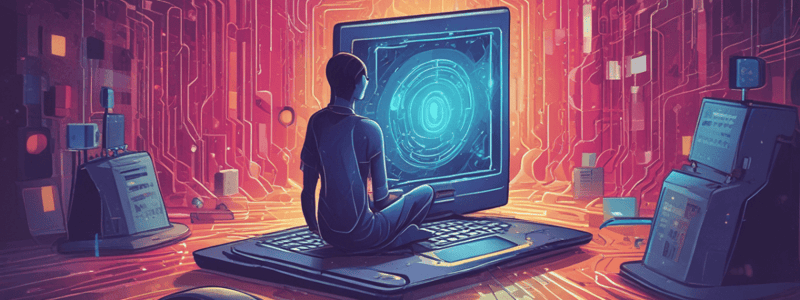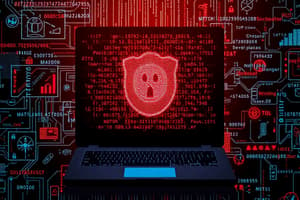Podcast
Questions and Answers
What is the primary motivation behind data exfiltration attacks?
What is the primary motivation behind data exfiltration attacks?
- To promote a political cause
- To steal sensitive or proprietary information (correct)
- To cause service disruption
- To extort money from victims
Which type of cyberattack is motivated by ideological or political reasons?
Which type of cyberattack is motivated by ideological or political reasons?
- Financial gain attacks
- Service disruption attacks
- Blackmail attacks
- Philosophical/political belief attacks (correct)
What type of attack aims to steal secret information from organizations, often involving nation-states?
What type of attack aims to steal secret information from organizations, often involving nation-states?
- Financial gain attacks
- Data exfiltration attacks
- Espionage attacks (correct)
- Chaos attacks
Which motivation is typically associated with organized crime in the context of cyberattacks?
Which motivation is typically associated with organized crime in the context of cyberattacks?
What characterizes ethical attacks or white-hat hacking?
What characterizes ethical attacks or white-hat hacking?
What is the goal of blackmail attacks in the context of cybercrime?
What is the goal of blackmail attacks in the context of cybercrime?
Which of the following best describes revenge attacks?
Which of the following best describes revenge attacks?
Disruption/chaos attacks are primarily aimed at what?
Disruption/chaos attacks are primarily aimed at what?
Which of the following best describes insider threats?
Which of the following best describes insider threats?
Which method do attackers commonly use to gain initial access to an organization?
Which method do attackers commonly use to gain initial access to an organization?
What is an example of a motivation for cyber espionage?
What is an example of a motivation for cyber espionage?
How do attackers typically exploit cloud services?
How do attackers typically exploit cloud services?
What role does threat intelligence play in cybersecurity?
What role does threat intelligence play in cybersecurity?
Which of the following actors is most likely to pursue a sophisticated attack strategy?
Which of the following actors is most likely to pursue a sophisticated attack strategy?
What does the term 'shadow IT' refer to in the context of organizational security?
What does the term 'shadow IT' refer to in the context of organizational security?
What differentiates unskilled attackers from more advanced threats?
What differentiates unskilled attackers from more advanced threats?
Why are unskilled attackers considered a security threat despite their low skill level?
Why are unskilled attackers considered a security threat despite their low skill level?
What is a common motivation behind the actions of unskilled attackers?
What is a common motivation behind the actions of unskilled attackers?
In what type of environments are unskilled attackers most frequently found targeting victims?
In what type of environments are unskilled attackers most frequently found targeting victims?
Which characteristic defines unskilled attackers when it comes to their approach to targets?
Which characteristic defines unskilled attackers when it comes to their approach to targets?
How does the availability of hacking tools influence unskilled attackers?
How does the availability of hacking tools influence unskilled attackers?
What prevents unskilled attackers from being a greater threat despite their numbers?
What prevents unskilled attackers from being a greater threat despite their numbers?
Which of the following statements is true regarding the impact of unskilled attackers?
Which of the following statements is true regarding the impact of unskilled attackers?
What is the primary goal of security professionals regarding attack surfaces?
What is the primary goal of security professionals regarding attack surfaces?
Which of the following is NOT a method of message-based threat vectors?
Which of the following is NOT a method of message-based threat vectors?
What is one common characteristic of phishing attacks?
What is one common characteristic of phishing attacks?
How do attackers often gain access to an organization's systems?
How do attackers often gain access to an organization's systems?
What is a key motivation for military units and civilian groups to use hacking?
What is a key motivation for military units and civilian groups to use hacking?
Which threat vector is considered one of the most commonly exploited by attackers?
Which threat vector is considered one of the most commonly exploited by attackers?
What is an implication of a successful phishing attack?
What is an implication of a successful phishing attack?
Which method is used to gather information through social engineering techniques?
Which method is used to gather information through social engineering techniques?
What is a characteristic of unskilled attackers?
What is a characteristic of unskilled attackers?
Which type of attacker most likely has virtually limitless resources?
Which type of attacker most likely has virtually limitless resources?
What motivates organized crime to engage in cybersecurity attacks?
What motivates organized crime to engage in cybersecurity attacks?
Which of the following is likely an indicator of a threat actor involved in corporate espionage?
Which of the following is likely an indicator of a threat actor involved in corporate espionage?
What could indicate the involvement of an advanced persistent threat (APT) actor?
What could indicate the involvement of an advanced persistent threat (APT) actor?
Which type of threat actor is most likely to operate through dark web markets?
Which type of threat actor is most likely to operate through dark web markets?
Data exfiltration is most commonly associated with which type of attacker?
Data exfiltration is most commonly associated with which type of attacker?
What distinguishes nation-state actors from other types of threat actors?
What distinguishes nation-state actors from other types of threat actors?
Flashcards are hidden until you start studying
Study Notes
Motivations Behind Cyberattacks
- Data exfiltration aims to acquire sensitive or proprietary information, like customer data or intellectual property.
- Espionage involves stealing secret information, often between nation-states or corporate rivals.
- Service disruption attacks target critical systems (e.g., banking, health-care), causing interruptions.
- Blackmail seeks to extort victims by threatening to release sensitive information or continue attacks.
- Financial gain focuses on money theft or fraud, common among organized crime groups.
- Philosophical or political beliefs drive hacktivists to promote specific ideologies or causes.
- Ethical attacks, also known as white-hat hacking, aim to uncover vulnerabilities with organization consent.
- Revenge attacks are motivated by personal vendettas, targeting individuals or organizations for retribution.
- Disruption/chaos attacks aim to create disorder and interrupt normal operations.
- War can also motivate cyberattacks, often tied to national interests.
Characteristics of Threat Actors
- Cyber attackers vary in sophistication, from unskilled individuals using simple scripts to advanced persistent threats (APTs) that utilize advanced techniques.
- Resources available to attackers differ significantly; organized crime often has extensive funding, unlike hobbyist attackers.
- Intent and motivation play roles in attack types, with some seeking thrills (unskilled) versus others pursuing financial or political objectives.
Attack Techniques and Vectors
- Attackers may gain initial access via various methods including the Internet, wireless networks, or direct physical access.
- Common tactics involve social engineering through email or social media, or using removable media to compromise networks.
- Shadow IT systems can introduce vulnerabilities by exposing data to unapproved applications or devices.
- Supply chain interference is a strategy employed by sophisticated attackers to disrupt organizations.
Role of Threat Intelligence
- Threat intelligence informs organizations of potential threats and vulnerabilities through public and private sources.
- Security teams combine external intelligence with their analytics to identify indicators of compromise.
- Understanding different threat actors—unskilled attackers, hacktivists, organized crime, APTs, and insider threats—is essential for effective defense.
Understanding Unskilled Attackers
- Script kiddies refer to unskilled attackers who rely on downloaded tools rather than in-depth understanding.
- While they may seem less dangerous, their access to automated tools makes them a persistent threat.
- Unskilled attackers often target vulnerable organizations indiscriminately, including schools and universities, as they're convenient targets.
- Motivations frequently center around proving their hacking abilities rather than achieving financial gain.
Attack Surfaces and Vectors
- Attack surfaces include systems, applications, or services with vulnerabilities that attackers can exploit.
- Reducing the attack surface is key for security professionals to mitigate risks.
- Email is a primary threat vector, facilitating phishing, spam, and other attacks that can compromise multiple users.
- Attackers only need one successful phishing attempt to access an organization's network.
- Other communication methods, like SMS (smishing), instant messaging, and voice (vishing), can also serve as threat vectors.
Studying That Suits You
Use AI to generate personalized quizzes and flashcards to suit your learning preferences.




